
A cable-stayed bridge has one or more towers, from which cables support the bridge deck. A distinctive feature are the cables or stays, which run directly from the tower to the deck, normally forming a fan-like pattern or a series of parallel lines. This is in contrast to the modern suspension bridge, where the cables supporting the deck are suspended vertically from the main cable, anchored at both ends of the bridge and running between the towers. The cable-stayed bridge is optimal for spans longer than cantilever bridges and shorter than suspension bridges. This is the range within which cantilever bridges would rapidly grow heavier, and suspension bridge cabling would be more costly.

Zhenjiang, alternately romanized as Chinkiang, is a prefecture-level city in Jiangsu Province, China. It lies on the southern bank of the Yangtze River near its intersection with the Grand Canal. It is opposite Yangzhou and between Nanjing and Changzhou. Zhenjiang was formerly the provincial capital of Jiangsu and remains as an important transportation hub. As of the 2020 census, its total population was 3,210,418 inhabitants whom 1,266,790 lived in the built-up area made of the 3 urban districts. The town is best known both in China and abroad for its fragrant black vinegar, a staple of Chinese cooking.

Hangzhou Bay Bridge is a long 35.7 km (22.2 mi) highway bridge with two separate cable-stayed portions, built across the mouth of Hangzhou Bay in the eastern coastal region of China. It connects the municipalities of Jiaxing and Ningbo in Zhejiang province.

The Runyang Yangtze River Bridge is a large bridge complex that crosses the Yangtze River in Jiangsu Province, China, downstream of Nanjing. The complex consists of two major bridges that link Zhenjiang on the south bank of the river and Yangzhou on the north. The bridge is part of the Yangzhou–Liyang Expressway. Construction of the bridge complex began in October 2000 and was completed ahead of schedule. The bridge cost 5.8 billion Yuan. The complex opened to traffic on April 30, 2005. The total length of the bridge complex is about 35.66 kilometres (22.16 mi). In between the two bridges is the island of Shiyezhou.

Tàizhōu is a prefecture-level city in central Jiangsu province in eastern China. Situated on the north bank of the Yangtze River, it borders Nantong to the east, Yancheng to the north and Yangzhou to the west.

An extradosed bridge employs a structure that combines the main elements of both a prestressed box girder bridge and a cable-stayed bridge. The name comes from the word extrados, the exterior or upper curve of an arch, and refers to how the "stay cables" on an extradosed bridge are not considered as such in the design, but are instead treated as external prestressing tendons deviating upward from the deck. In this concept, they remain part of the main bridge superstructure.
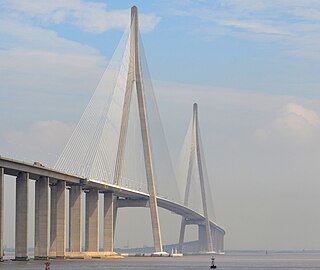
The Sutong Yangtze Bridge is a cable-stayed bridge that spans the Yangtze in China between Nantong and Changshu, a satellite city of Suzhou, in Jiangsu province.
The Chonghai Bridge is a proposed bridge to span the northern distributary at the mouth of the Yangtze River in the People's Republic of China. The bridge, along with the Chongqi Bridge and the Shanghai Yangtze River Tunnel and Bridge, is to connect the city of Shanghai with the north bank of the Yangtze in Jiangsu Province via Chongming Island.
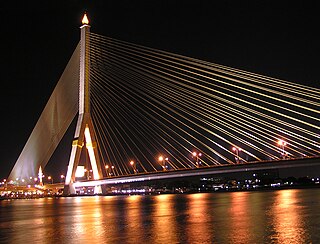
The Rama VIII Bridge is a cable-stayed bridge crossing the Chao Phraya River in Bangkok, Thailand. It was built to alleviate traffic congestion on the nearby Phra Pinklao Bridge. Construction of the bridge took place from 1999 to 2002. The bridge was opened on 7 May 2002 and inaugurated on 20 September, the birth anniversary of the late King Ananda Mahidol, after whom it is named. The bridge has an asymmetrical design, with a single pylon in an inverted Y shape on the west bank of the river. Its eighty-four cables are arranged in pairs on the side of the main span and in a single row on the other. The bridge has a main span of 300 metres (980 ft), and was one of the world's largest asymmetrical cable-stayed bridges at the time of its completion.

The Shanghai Yangtze River Tunnel and Bridge is a bridge–tunnel complex across the south fork of the Yangtze River near the river mouth in Shanghai. The tunnel connects the Pudong District of Shanghai on the south bank of the river with Changxing Island, while the bridge connects Changxing Island with Chongming Island. In combination with the Chongqi Bridge, which connects Chongming Island to the north bank of the Yangtze, the bridge–tunnel complex forms the final crossing of the Yangtze before it empties into the East China Sea.
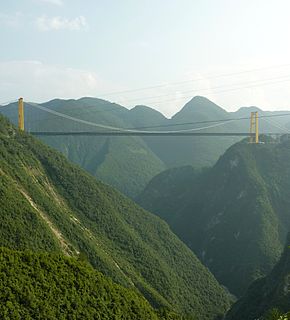
The Sidu River Bridge is a 1,222 m-long (4,009 ft) suspension bridge crossing the valley of the Sidu River near Yesanguan in Badong County of the Hubei Province of the People's Republic of China. The bridge was designed by CCSHCC Second Highway Consultants Company, Limited. and built at a cost of 720 million yuan. It opened to traffic on November 15, 2009.

The bridges and tunnels across the Yangtze River carry rail and road traffic across China's longest and largest river and form a vital part of the country's transportation infrastructure. The river bisects China proper from west to east, and every major north–south bound highway and railway must cross the Yangtze. Large urban centers along the river such as Chongqing, Wuhan, and Nanjing also have urban mass transit rail lines crossing the Yangtze.

The Jiangyin Yangtze River Bridge is a suspension bridge over the Yangtze River in Jiangsu, China. The bridge has a main span of 1,385 metres (4,544 ft) connects Jiangyin south of the river to Jingjiang to the north. When the bridge was completed in 1999, it was the fourth longest suspension bridge span in the world and the longest in China. Several longer bridges have since been completed in China and abroad, and it is currently the 15th longest suspension bridge in the world. The bridge was also the furthest downstream on the Yangtze until the completion of the Sutong Yangtze River Bridge in 2008 and the Chongming–Qidong Yangtze River Bridge in 2011.
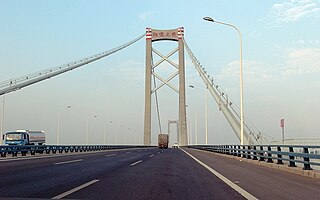
The Yangluo Yangtze River Bridge is a suspension bridge over the Yangtze River in Wuhan, Hubei, China. With a main span of 1,280 metres (4,200 ft), at its opening it was tied with the Golden Gate Bridge as the ninth longest suspension bridge in the world. The bridge carries the G70 Fuzhou–Yinchuan Expressway and G4201 Wuhan Ring Expressway over the Yangtze River and provides easy access to both sides of the river as part of a larger plan to promote development in the eastern portion of the city. Construction on the bridge began on November 4, 2003, and it opened to traffic on December 26, 2007.

The Shenyang–Haikou Expressway, commonly referred to as the Shenhai Expressway is an expressway in China that connects the cities of Shenyang, Liaoning, and Haikou, Hainan. When fully complete, it will be 3,710 km (2,310 mi) in length. One of its oldest portions is the Shenyang–Dalian Expressway, or Shenda Expressway is a 400 km (250 mi) expressway that connects Shenyang and Dalian, the two largest cities of China's Liaoning province.
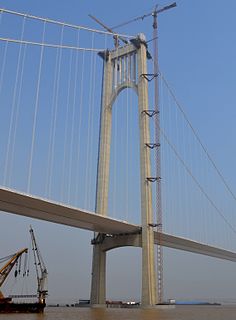
The Nanjing Qixiashan Yangtze River Bridge, formerly Fourth Nanjing Yangtze Bridge, is a suspension bridge over the Yangtze River in Nanjing, China. The bridge is the 11th longest span in the world and the sixth largest in China. The bridge has renamed on 20 December 2019.
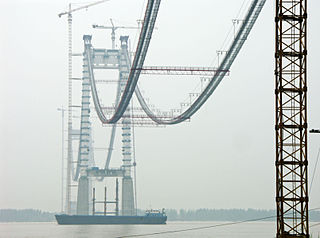
The Ma'anshan Yangtze River Bridge is a bridge complex over the Yangtze River in Ma'anshan, Anhui Province in eastern China. The bridge complex carries a six-lane highway over two branch streams of the Yangtze and the island of Xiaohuangzhou in the middle of the river.

The Dongshuimen Bridge and the Qiansimen Bridge, known collectively as the Twin River Bridges, are a pair of bridges that form a road and rail connection in Chongqing, China. Consisting of two cable-stayed bridges and a tunnel across the Yuzhong peninsula where the heart of Chongqing's commercial & financial district Jiefangbei CBD is located, the connection opened in 2014.
Wuhan Zhuankou Yangtze River Bridge, also known as Zhankou Yangtze River Highway Bridge, formerly known as Huangjiahu Yangtze River Bridge, Is a highway cable-stayed bridge located in Wuhan, Hubei, China, which crosses the Yangtze River and connects the Caidian District on the north shore of the Qingling Subdistrict of Xujiabao and the south bank are one of the important components and control engineering of Wuhan Fourth Ring Road, and Wuhan Junshan Yangtze River Bridge 9.2 kilometers, 7 kilometers from the Baishazhou Yangtze River Bridge downstream. The total length of the bridge is 5.296 kilometers. The main bridge structure is a five-span, one-twin, twin tower face steel box girder cable-stayed bridge with a main span of 760 meters and a bridge width of 46 meters.


















